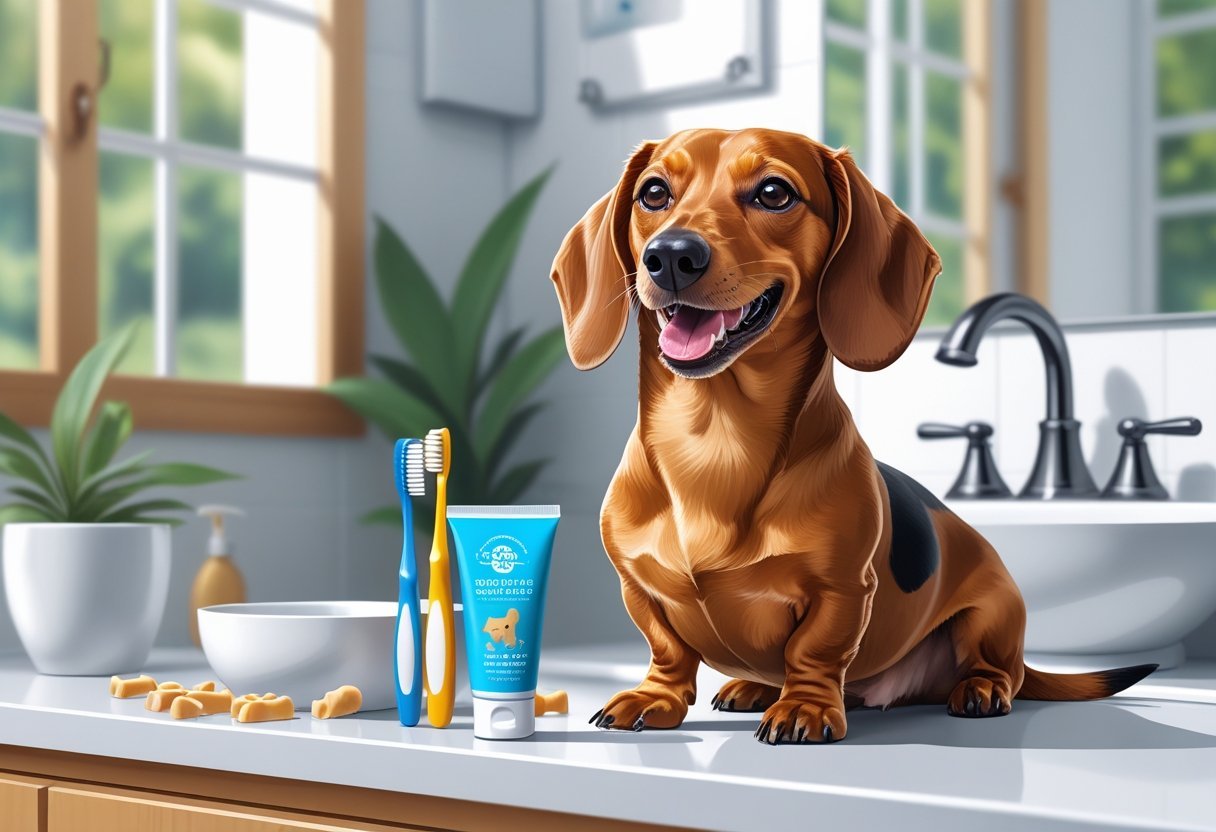Watching your dachshund go through back surgery is tough 😔. You want to do everything right, but it can feel overwhelming.
Knowing what to do after back surgery makes a huge difference in how well your dachshund heals 🐾 and how comfortable they feel at home 🏡. This guide breaks down every important step, from what happens right after surgery to daily routines that really help 💡.
You’ll find tips on setting up a safe space 🛏️, what exercises support healing 🧘♀️, and which signs mean you need to call your vet 📞. Recovery isn’t just about your dachshund’s body—their mood and behavior matter too 🧠.
When you follow these tips, you give your dog a real shot at a smoother, less stressful recovery 🌈.
Key Takeaways 📝
- You need to follow specific care steps after your dachshund’s back surgery. 🐶
- Support includes daily routines, safe home setup, and noticing important signs. 🏠
- Knowing when to get help from your vet is important for recovery. 🩺
🐾 Free Dachshund Care Guide
Download our free checklist to ensure your Dachshund stays happy, healthy, and well-loved!
Get Your Free Guide 🐶Understanding Dachshund Back Surgery Recovery
Dachshunds need careful recovery after back surgery because of their long backs and short legs 🐾. Their unique anatomy puts them at higher risk for spinal problems 🦴.
If you know what happens after surgery and why these dogs have trouble, you can support your dachshund better 💛.
What To Expect After Surgery 🛏️
After IVDD surgery, your dachshund might feel weak or struggle to move their back legs 🐕. Some need help standing or even going outside 🚶.
Strict rest is a must—usually for 4 to 6 weeks ⏳. Vets often recommend a crate to keep your pup safe and still 🧺.
Watch closely for pain, swelling, or changes in bladder and bowel habits 🚨. Pain medicine and anti-inflammatories are common, and some dogs need physical therapy too 💊.
Physical therapy helps muscles regain strength and encourages healing 🧘. Here are some signs you might see during recovery:
- Tiredness or low activity 😴
- Less appetite 🍽️
- Needing help to move 🐾
- Using a sling for support 🩹
Check in with your vet often and let them know about any changes 📞. Keep your dog on leash, and try non-slip mats to avoid falls or slips 🦺.

🥗 Wild Earth Dog Food – Clean Nutrition for Healthier Doxies
This vet-developed, plant-based dog food supports digestion, immunity, and energy—perfect for your sensitive or allergic Dachshund.
- ✅ 100% cruelty-free and vegetarian
- ✅ Promotes healthy weight & shiny coat
- ✅ No fillers, artificial flavors, or animal byproducts
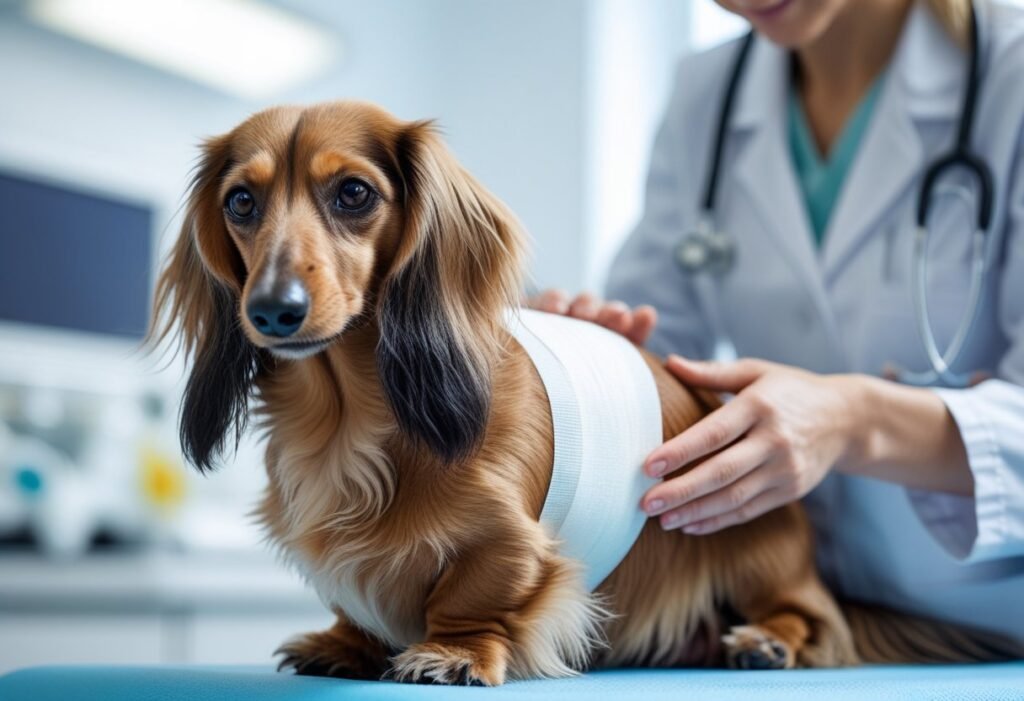
Dachshund Anatomy And IVDD Risks 🦴
Dachshunds’ long backs and short legs make them more likely to have spinal disk problems like IVDD (Intervertebral Disc Disease) 🐶. IVDD shows up when the soft discs between their spine bones bulge, break, or slip ⚠️.
That long back puts extra stress on their spine, especially if they jump or climb stairs 🪜. Age or genetics can make IVDD even more likely 🧬.
If a disc slips or ruptures, it can press on the spinal cord and cause pain or even paralysis 🚑. Signs of IVDD in dachshunds include:
- Sudden pain or crying out 😢
- Weak or wobbly back legs 🐕🦺
- Trouble standing or walking 🚷
- No interest in usual activities 🎾
If you know about these risks, you’ll understand why monitored recovery is so important 🧠. Special care gives your dachshund the best chance to heal up and avoid more damage ❤️.
Immediate Post-Surgical Care
Dachshund back surgery recovery really starts right after the operation 🐾. The first days matter a lot for healing 🛏️.
You’ll need to monitor pain, check the incision, and know when your dachshund is ready to come home 🩺.
Hospital Recovery Timeline 🏥
Right after surgery, your dachshund usually stays at the veterinary hospital for 2 to 7 days 📆. The length depends on the surgery, your dog’s health, and how well they wake up and move after anesthesia 💉.
Key checkpoints in hospital recovery:
- Day 1–2: Staff watch your dog closely for pain and movement. 👀
- Day 3–4: Most dachshunds start gentle movement and bathroom breaks. 🚽
- Day 5–7: If things look good, the vet will send you home with discharge instructions. 📋
The vet checks bladder and bowel control, pain levels, and whether your dog can stand or walk with help 🐶. Dogs with severe nerve damage may need to stay longer 🧠.
Pain Management Strategies 💊
Keeping your dachshund comfortable is so important ❤️. After surgery, vets usually give strong pain meds like opioids or NSAIDs 💉.
They’ll start with injections in the hospital, then switch to pills or liquid at home 🍼. Pain control lets your dog rest and heal better 🌙.
Watch for signs of pain:
- Whining or barking 🗣️
- Refusing to eat or move 🍽️
- Tense muscles or trembling 😰

🩺 The Swiftest Pet Insurance – Peace of Mind for Your Doxie’s Recovery
Back surgery and rehabilitation can be emotionally and financially stressful. The Swiftest helps you compare trusted pet insurance plans side-by-side, ensuring your Dachshund gets the care they deserve — without delay or worry.
- ✅ Covers surgery, physical therapy, and post-op medications 🏥
- ✅ Compare multiple providers to find affordable options 💰
- ✅ Quick, transparent results — tailored to your Dachshund’s needs 🐾
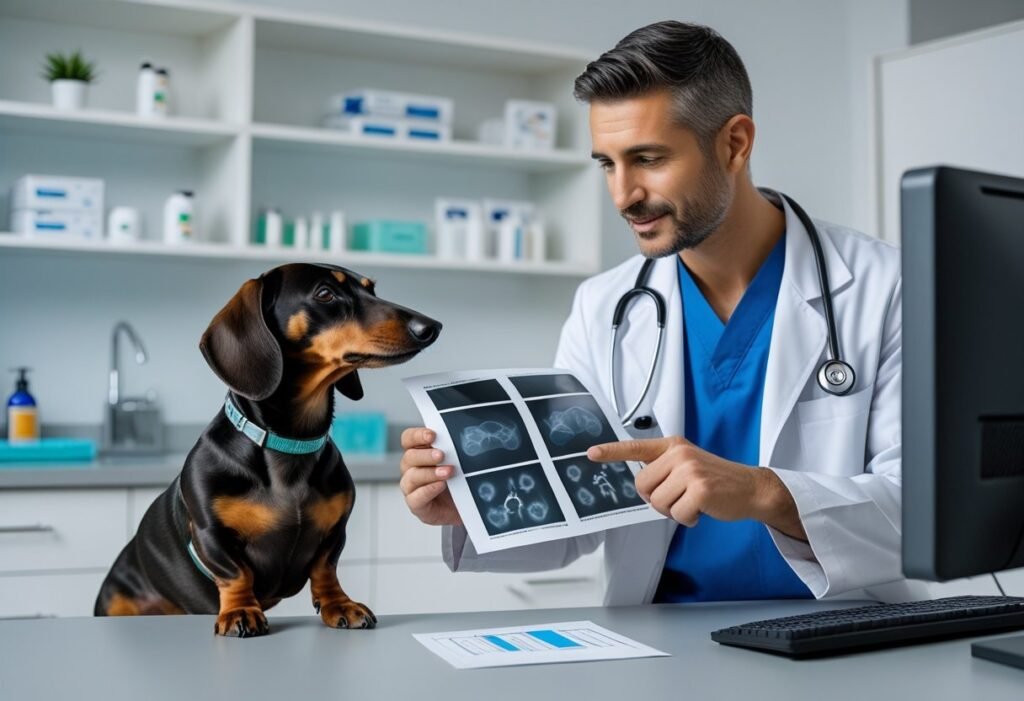
Common pain medicines after back surgery:
| Medicine Type | Examples | Notes |
|---|---|---|
| Opioids | Tramadol, Fentanyl | Given short-term |
| NSAIDs | Carprofen | For inflammation |
| Gabapentin | – | For nerve pain |
Stick to the dosage instructions and call your vet if your dog acts strange, stops eating, or vomits 🚨.
Monitoring Incision And Signs Of Complications 🔍
Check the surgical incision at least twice a day 📆. The skin should look clean and dry, maybe a little pink or swollen 🌸.
You might see mild bruising, but you shouldn’t see bleeding or weird discharge (like yellow, green, or thick white fluid) 🚫.
Watch for these complications:
- Redness spreading from the incision 🔴
- Foul odor or pus 🤢
- Fever or shivering 🌡️
- Refusing to eat for more than a day 🍽️
If you see any of those, call your vet right away 📞. Don’t let your dachshund lick or chew the stitches—use an e-collar or surgical suit if you have to 🐕🦺.
Follow your vet’s cleaning instructions and keep your dog in a dry, safe spot away from other pets 🧼. Good incision care really matters for a successful recovery 🧡.
At-Home Care And Environment Setup

Your dachshund needs a quiet, secure place to heal after back surgery 🛏️. The right setup and tools can help prevent injury and make rehab after IVDD a lot easier 🧠.
Safe Resting Spaces 🧺
Set up a small, comfy area for your dog to rest 🐶. You can use a playpen, crate, or a small room with soft bedding that won’t bunch up 🧸.
Pick a spot away from busy areas and loud noises 🔇. Keep the bed low and firm so your dachshund can move easily without climbing 🪑.
Avoid stairs, furniture, or high surfaces 🚫. Put food, water, and pee pads close by so your dog doesn’t have to walk far 🍽️.
Check the space every day for hazards ⚠️. Remove loose rugs and anything your dog could trip on 🚷.
Use baby gates or barriers to block off unsafe spots 🚧. Here’s a quick table of do’s and don’ts:
| Do | Don’t |
|---|---|
| Use firm bedding | Let your dog jump |
| Place food nearby | Allow roaming |
| Limit activity | Place bed on sofa |

👨🍳 ChefPaw Fresh Food Maker
- ✅ Make healthy meals with whole ingredients
- ✅ Perfect for Dachshunds with food allergies
- ✅ Ditch preservatives and fillers for good
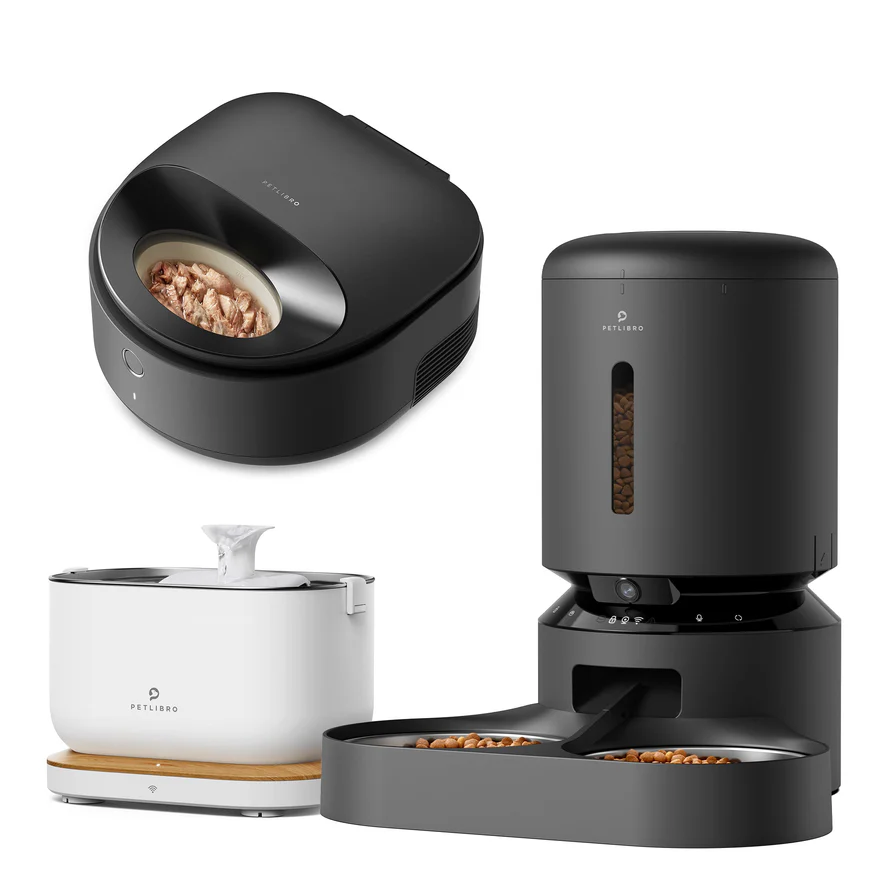
⏲️ Petlibro Smart Feeder
- ✅ Custom meal scheduling via mobile app
- ✅ Keeps portion control consistent
- ✅ Great for busy pawrents and picky eaters
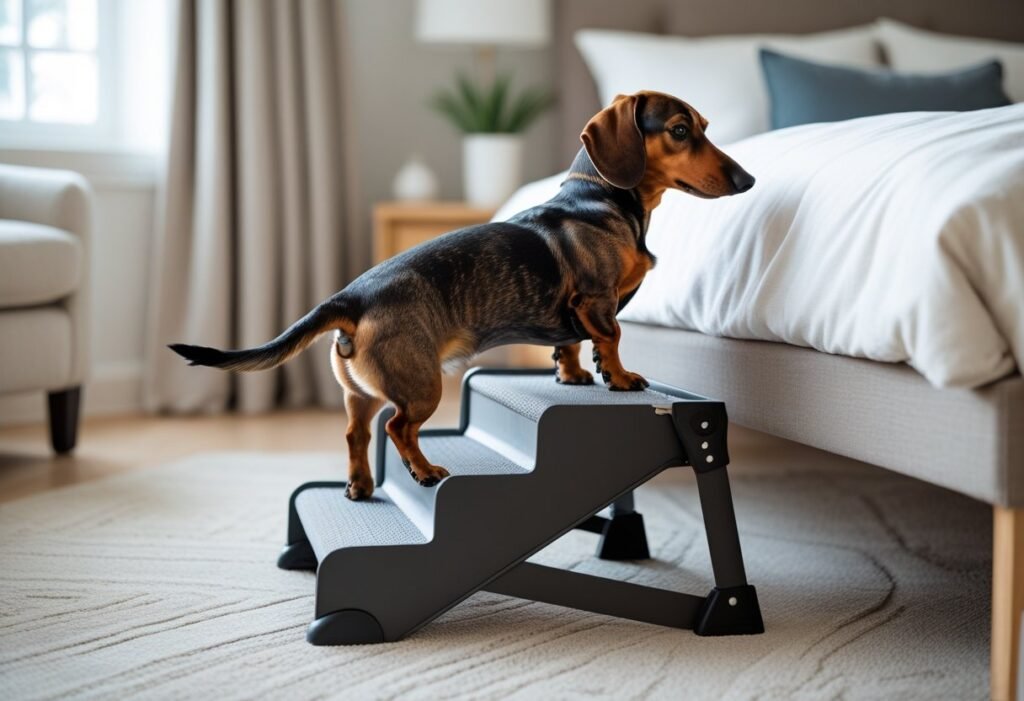
🎉 Grab your free Dachshund care checklist!
Mobility Aids And Slings 🦮
Help your dachshund walk, especially in the first weeks after surgery 🚶♂️. A sling or harness supports their back and makes bathroom breaks safer 🚽.
A rear support sling helps if your dog’s back legs are weak 🦵. Just loop it under their belly to lift their rear 🔄.
A body harness gives you more control and spreads out pressure, which makes things less painful for your dog ❤️.
If your vet suggests it, use ramps instead of steps. Pick ramps with good grip and the right size for your dog 🛞.
Always supervise your dachshund with new aids and check that everything fits right 👀. Clean slings and harnesses often 🧼.
Don’t drag or pull your dog if they resist—use gentle encouragement and let them move at their pace 🐾.
Physical Rehabilitation And Exercises

Getting strength and mobility back after dachshund back surgery takes hands-on exercises, some water therapy, and a lot of patience 🐕🦺. Your dachshund’s daily routine will revolve around gentle movement, safe activities, and watching closely for progress or problems 🔄.
Physical Therapy Techniques 🧘♂️
Physical therapy helps rebuild muscle and coordination after IVDD surgery 💪. Passive range of motion (PROM) exercises are super helpful ✅.
Move your dachshund’s legs gently, one at a time, to keep joints flexible and stop stiffness 🦵. Do this a few times a day, or as your vet suggests ⏱️.
Massage therapy can ease discomfort and boost blood flow to healing spots 💆. Use light strokes on the back and legs, but be extra careful around the incision ⚠️.
Controlled leash walks are another good option 🚶♀️. Start with just a couple minutes in a safe spot and slowly add time as your dachshund gets stronger 🌱.
Consistency really matters. Daily sessions help your dog recover faster, but always listen to your vet’s advice 🎯.
If your dog shows pain, whines, gets suddenly weak, or loses balance, stop right away and talk to your vet 📞.

🛏️ Majestic Pet Orthopedic Bed
- ✅ Provides joint and spinal support during recovery 🩺
- ✅ Memory foam base relieves pressure points and soreness 💛
- ✅ Soft, washable cover keeps your Doxie cozy and clean 🐾

🪜 Majestic Pet Stairs
- ✅ Reduces strain by helping your Doxie move safely post-surgery ⚕️
- ✅ Soft foam steps are gentle on healing joints and backs 🐶
- ✅ Lightweight and stable — perfect for couches or beds 🏡
Hydrotherapy Benefits 💧
Hydrotherapy uses water to help your dachshund exercise without stressing healing joints or the spine 🚿. An underwater treadmill usually comes into play during IVDD recovery 🐾.
This treadmill lets your dog walk with support, and the water gently takes some of their weight off 🌊. It’s a pretty clever setup 🧠.
Hydrotherapy can improve muscle tone and joint movement 💪. It also tends to make activity less painful 😌.
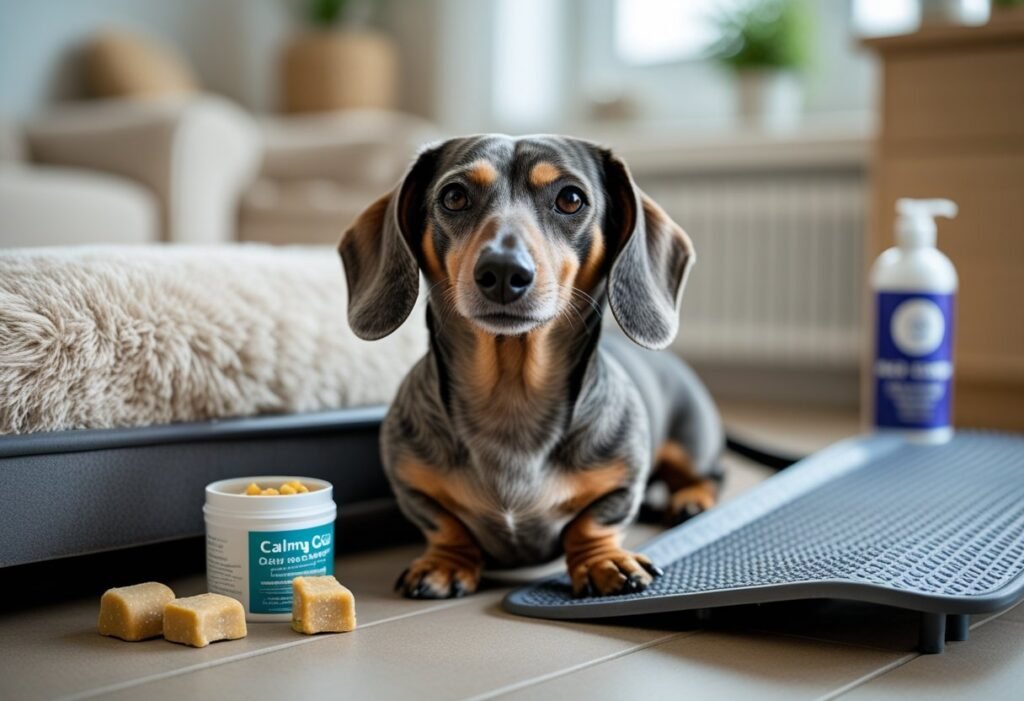
Warm water relaxes your dog’s muscles, so movement feels easier ♨️. Some programs add gentle swimming, but only if your vet gives the green light ✅.
Professionals should run hydrotherapy sessions. Always dry your dachshund thoroughly after water therapy to lower the risk of skin issues 🧼.
Over time, you might notice stronger walking and better limb use 🚶. It’s a slow process, but you’ll probably see progress if you stick with it ⏳.
Monitoring Progress And Adjustments 📋
Tracking your dachshund’s progress matters for safe recovery 🐾. A simple table can help you keep records:
| Date | Activity | Time Spent | Notes (Energy/Issues) |
|---|---|---|---|
| 2025-06-04 | Leash Walk | 3 mins | Slight limp, no pain |
| 2025-06-05 | Hydrotherapy | 7 mins | Good energy |
Keep an eye out for changes in strength, alertness, or your dog’s ability to walk or stand 🧐. If your pup seems tired, stressed, or struggles with things they could do before, ease up on exercise and call your vet 📞.
Adjust the rehab plan as your dachshund heals 🛠️. Safety comes first—always. 🧡
Nutritional Support For Healing

Good nutrition matters when your dachshund’s recovering from back surgery 🥣. The right food and supplements can boost healing, energy, and comfort 🐾.
Recommended Diet After Surgery 🍽️
Feed your dachshund high-quality, balanced dog food that’s easy to digest . Look for real meat as the main ingredient and skip fillers like corn or soy 🚫.
A mix of proteins, healthy fats, and fiber helps with muscle strength and digestion 💪. Fresh water should always be nearby, especially for healing pups 💧.
Watch those portion sizes—extra weight puts more stress on your dog’s back ⚖️. If your vet suggests, you can give boiled chicken, plain rice, or low-sodium broth for a gentle meal in the first days after surgery 🥄.
Gradually switch back to your dog’s regular food as they get better 🔁. Keep an eye out for tummy trouble, like vomiting or diarrhea 🤢.
A sample meal plan:
| Meal | Description |
|---|---|
| Breakfast | Premium dry kibble or wet food |
| Lunch | Small portion of lean, cooked chicken |
| Dinner | Regular dog food, with steamed veggies |
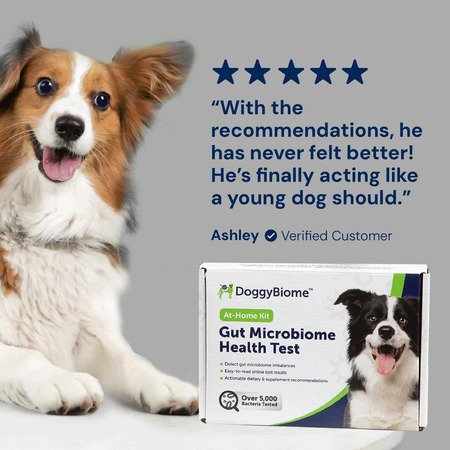
🧬 AnimalBiome Gut Health Test Kit
- ✅ Monitors your Dachshund’s gut balance after surgery 🩺
- ✅ Helps identify bacteria changes caused by medications 💊
- ✅ Supports smoother digestion and immune recovery 🌿

🌿 Innovet PurCBD Oil
- ✅ Helps reduce post-surgery pain and inflammation 🐾
- ✅ Promotes calmness for better rest and recovery 🛏️
- ✅ 100% plant-based, vet-approved, and gentle for daily use 🌱
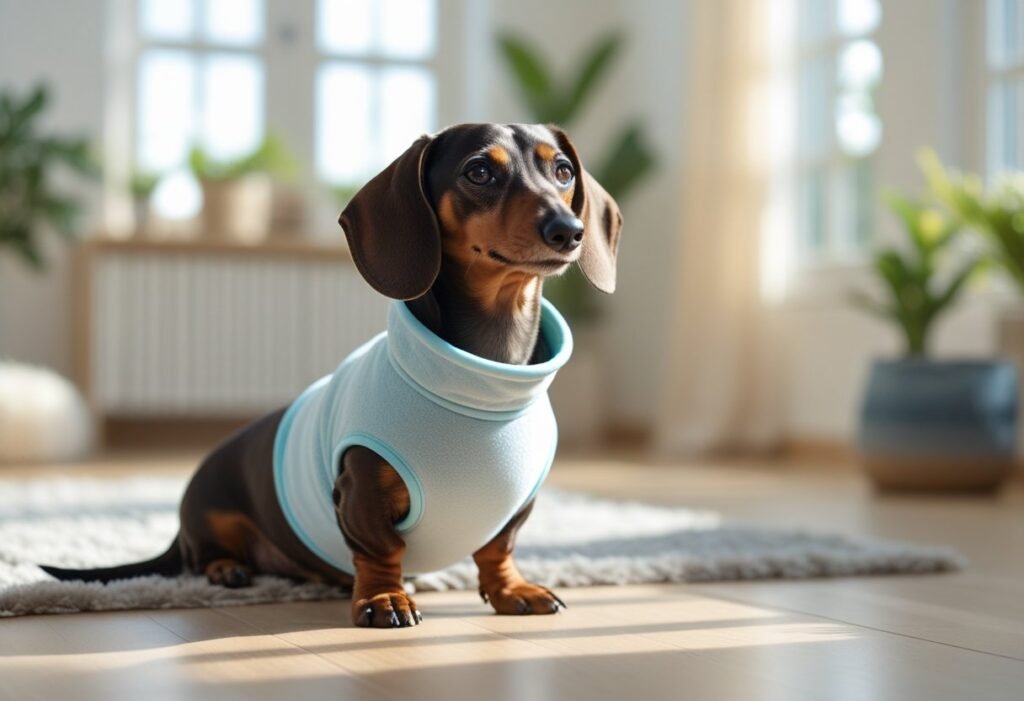
Supplements For Recovery 💊
Supplements can help, but only use what your vet recommends 🩺. Omega-3 fatty acids may reduce swelling and support nerve health 🧠.
Glucosamine and chondroitin can help the joints and spine, but dosing needs to be right ⚙️. Vitamin E and vitamin C support the immune system and tissue repair 🌿.
Probiotics might help prevent tummy issues, especially after antibiotics 🦠. Don’t give human supplements—they can be risky for dogs 🚫.
Always ask your vet before starting anything new. Watch for side effects like vomiting, diarrhea, or appetite changes, and stop if you notice problems ❗
A supplement schedule example:
- Morning: Fish oil capsule 🐟
- With meals: Probiotic powder added to food 🍽️
- Evening: Glucosamine tablet (if approved by vet) 🌙
Managing Emotional Well-being

Your dachshund’s emotional health matters just as much as the physical stuff 🧠. Helping them feel safe and calm makes healing smoother 💛.
Preventing Stress And Anxiety 😟
After surgery, your dachshund might feel confused or a bit nervous 😔. Loud noises or lots of visitors can crank up the anxiety 📢.
Create a quiet resting spot away from the action 🛏️. Toss in favorite blankets and toys for comfort 🧸.
Stick to a calm, predictable environment 🧘. Move gently when picking up or setting down your pup 🤲.
If your dachshund shows signs of stress—like whining or hiding—try to cut back on noise and avoid sudden changes ⚠️. Short, soothing moments like gentle petting can help 🐾.
Talk in a soft, steady voice 🗣️. Skip punishment for mistakes; it just adds fear 🚫. If anxiety sticks around, ask your vet about safe options 🩺.

📹 Petcube Cam 360
- ✅ Keep an eye on your recovering Dachshund anytime, anywhere 🏡
- ✅ Detect early signs of discomfort or movement issues 🩺
- ✅ Talk and soothe your Doxie remotely for peace of mind 💬
📍 Tractive DOG GPS Tracker
- ✅ Monitor your Dachshund’s location and gentle walks safely 🌳
- ✅ Track activity levels to support post-surgery rehabilitation ⚕️
- ✅ Peace of mind knowing your Doxie is always safe and nearby ❤️
Reintroducing Routine 🔁
Routine helps your dog feel more secure 🐶. Start bringing back usual feeding and bathroom times step by step 🕒.
Charts or alarms can help you remember new medication times ⏰. Restart daily things slowly—short leash walks for bathroom breaks, nothing wild just yet 🚶.
Avoid long walks, running, or letting your dog play with others until your vet says it’s okay 🐕. Keep meal times and spots consistent 🍽️.
Offer calm praise or a favorite treat for good behavior 🎁. Routines lower stress and support recovery 🌱. If your dachshund gets unsettled, keep things simple and only change a little at a time ⚖️.
Preventing Future Injuries In Dachshunds

Helping your dachshund steer clear of another back injury really matters 🛡️. The choices you make every day add up over time 📆.
Activity Modifications 🐾
Keep your dachshund on a leash during walks to avoid sudden moves that could hurt their back 🚶♂️. Don’t let your dog jump on or off furniture or stairs—it’s just not worth the risk 🪜.
Pet ramps and dog steps make moving around safer 🐕. Gentle, low-impact exercise is the way to go 🧘♀️.
Short, frequent walks beat one long walk any day 🚶. Skip fetch or any game that means quick chasing or sharp turns 🏃♂️.
Supervise playtime 👀. If your dachshund’s recovering from IVDD surgery, controlled activity supports rehab ⚙️. Slow and steady really does win here 🐢.
🌟 Recovery Comfort Essentials for a Happier, Healthier Healing Journey
- 💧 Petlibro Water Fountain — Encourage steady hydration to support healing, kidney health, and recovery after surgery. Fresh, filtered water keeps your Dachshund’s body balanced and energized.
- 🍪 Petcube Bites 2 — Stay connected and reward calm, gentle behavior during recovery. Monitor activity and offer treats remotely to comfort your Dachshund while you’re away.
- 🛁 Pride + Groom Grooming Tools Kit — Gentle grooming helps maintain skin and coat health, promoting relaxation and blood circulation — ideal for post-surgery self-care.
- 🧠 Brain Training for Dogs — Gentle mental exercises to keep your Doxie sharp and prevent boredom while physical activity is limited. Perfect for mental stimulation during rest time.
Long-term Care Strategies 🏥
Keep your dachshund at a healthy weight to take pressure off their spine ⚖️. Regular vet visits help catch back problems early 🔍.
Ask your vet about physical therapy or at-home exercises for ongoing rehab 💪. Use a harness instead of a collar on walks—it’s easier on the back and neck 🦴.
Pick beds with good support and a flat, firm surface 🛏️. Watch for changes in walking, jumping, or posture 👣.
Write down warning signs like limping, yelping, or not wanting to be touched 📝. If you spot any, call your vet 📞.
Quick Tips Table 🗂️
| Do | Avoid |
|---|---|
| Use ramps and harnesses | Jumping on/off furniture |
| Short, frequent walks | Long, rough play |
| Maintain healthy weight | Overfeeding |
| Monitor mobility | Ignoring new symptoms |
When To Consult Your Veterinarian

After your dachshund’s back surgery, staying alert really helps keep recovery on track 👀. Knowing when something’s off lets you act fast and avoid bigger issues 🚨.
Identifying Setbacks ⚠️
If your dachshund shows new pain, swelling, or cries out, call your vet right away 📞. Watch for dragging back legs, wobbling, or losing balance 🐾.
Other warning signs include:
- Lack of bladder or bowel control 🚫
- Refusing to eat or drink 🍽️
- Unusual tiredness or hiding 😴
Don’t ignore bleeding, discharge, or bad smells at the surgery site 🤢. These can mean infection or wound trouble 🩹.
Even small changes in behavior or movement may signal a setback 🔁. If things don’t improve or get worse, check with your vet 🩺.
💛 Recovery Essentials: Comfort, Calm & Care for a Smooth Healing Process
- 🦺 Embark Pet Adventure Harness – Gentle, no-pull support for controlled short walks during rehab; helps you keep movement safe and steady while your Doxie recovers.
- 🧫 AnimalBiome Gut Restore Capsules – Rebuilds gut balance after surgery and medications to improve appetite, nutrient absorption, and immune recovery.
- 🛁 King Klean Dog Shampoo (King Kanine) – Soothing, gentle formula that cleans without irritation, supporting skin comfort and calm during post-op grooming.
- 🧘♀️ Zumalka Calmpet Drops – Natural anxiety relief to help your Dachshund rest, reduce stress-related tension, and sleep more soundly during recovery.
- 🎨 Purr & Mutt Personalized Dachshund Art – A heartfelt keepsake to celebrate recovery milestones and keep morale high for you and your pup.
🐾 Small comforts and targeted care make recovery gentler — help your Doxie heal with calm, safety, and love. 💛
Regular Check-Ups 📋
Scheduled check-ups matter a lot after back surgery 🗓️. Your vet checks healing, looks at stitches or staples, and adjusts meds if needed 💊.
Stick to the check-up plan your vet gives you 📆. These visits catch small problems before they turn serious 🛡️.
At each visit, mention changes in appetite, energy, or movement ⚙️. Bring your list of questions or worries—your vet’s there to help 🧑⚕️.
Your vet might suggest physical therapy or tweaks to your recovery routine based on how your dachshund’s healing 💪. Dogs often need a little extra support as they recover ❤️.
🐾 Don’t Miss Out!
Download our free Dachshund care guide to keep your furry friend happy and healthy.
Get Your Free Guide 🐶Frequently Asked Questions

Strict rest, careful activity, and close monitoring matter after your dachshund has back surgery 🛌. Recovery times can really vary, and you’ll need to take extra care to prevent new injuries 🐾.
What are the recommended care practices for a Dachshund post-back surgery? 🐶
Keep your dachshund in a crate or small pen most of the day to limit movement 🧺. Take them outside on a leash just for bathroom breaks 🚶♀️.
Give meds as your vet says, and watch for changes in appetite, pain, or behavior 💊. Put non-slip mats on floors, and don’t let your pup jump on or off furniture 🚫.
Carry your dachshund up and down stairs during recovery. It’s safer that way 🪜.
What is the expected recovery timeline after a Dachshund undergoes IVDD surgery? ⏳
Most dachshunds start improving within two weeks after surgery 📅. Some need six to eight weeks for the spine to get strong enough for normal movement 💪.
Your vet will update you at check-ups and let you know when to ramp up activity 🩺. Some dogs take longer, especially if they couldn’t walk before surgery 🐾.
How can the quality of life be improved for a dog after IVDD surgery? 💛
Put ramps or steps by the furniture so your dog won’t try to jump 🛋️. Supportive, orthopedic beds help a lot, and keeping your dog’s weight in check takes pressure off their back ⚖️.
If your vet suggests it, try gentle physical therapy to help your dog rebuild strength 🧘♀️. It’s not always quick, but little by little, you might see progress 📈.
Stick with regular vet visits to track how your dog’s doing. Your vet can tweak the care plan if anything changes 📝.
Are there specific activities that should be avoided during the recovery period post-back surgery? 🚫
Don’t let your dog jump on or off furniture, and try to block off stairs 🪜. Running up or down steps just isn’t safe right now ⚠️.
Skip rough play and keep other pets from bumping into your dog 🐕. Off-leash walks? Not a good idea during recovery 🚷.
Honestly, carrying your Dachshund is usually safer than letting them wander around right after surgery 🧸. It’s a hassle, but it’s worth it 💯.
What signs of recovery should be expected in the weeks following back surgery for a dog? 👣
Watch for your dog moving their back legs, maybe standing, or even taking a few steps with help 🐾. It’s slow going, but a wagging tail or better bladder control are good signs 🚽.
When pain fades, you’ll probably notice your dog eating more and showing interest in things again 🍽️. If you spot new pain or weakness, don’t wait—call your vet right away 📞.
How to manage a dog who is not walking after undergoing IVDD surgery? 🦴
Talk to your vet about doing some at-home physical therapy or gentle exercises 🧘. When your dog needs to go outside, use a sling or harness to help them stand 🦮.
Keep their bedding clean and dry 🛏️. Move their legs gently, just like your vet showed you, so their joints don’t get stiff 👐.
Make sure you go to every follow-up appointment 📋. If you’re ever unsure, just ask your vet—they’ve seen it all 🧑⚕️.



